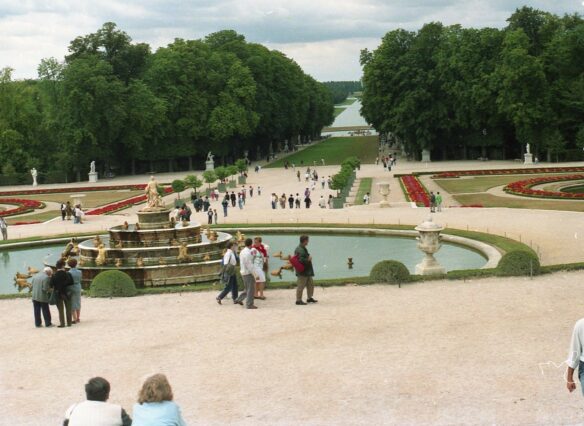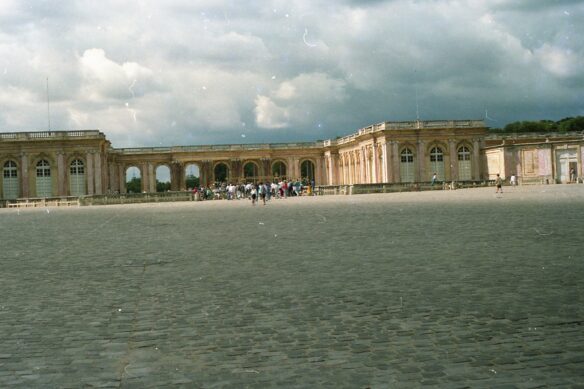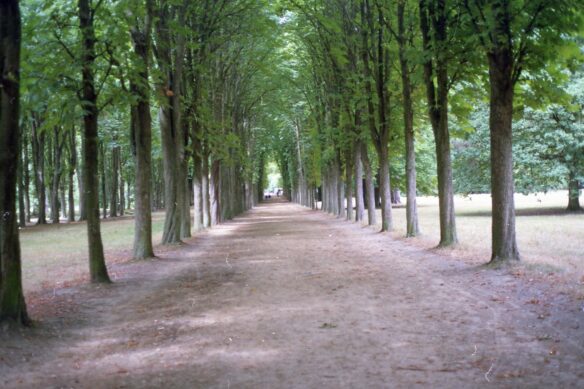
By Lee Weinstein: When my wife, Diane, and I planned a trip to Paris to take place in August of 1990, I was reminded of an oft-repeated story of an unusual event that happened a century earlier in nearby Versailles.
On August 10, 1901, two English academics, Charlotte Anne Moberly and Eleanor Jourdain, had a strange experience while touring the grounds of the Palace of Versailles. Miss Moberly was the principal of St. Hugh’s College for women in Oxford, and Miss Jourdain was headmistress of Corran Collegiate School, a private school for girls.
While vacationing together in Paris, they decided to visit Versailles, where they experienced what seemed to be a time slip back to the previous century. It began after they passed the Grand Trianon, a large chateau on the grounds while on their way to the Petit Trianon, a smaller chateau given by the king to Marie Antoinette. It was between the two Trianons that they lost their way. Both later independently reported they had felt a sense of oppression, as well as feeling of unreality, as if everything had become flat and lifeless.

As they got closer to the Petit Trianon, they saw two strangely dressed men in long green-gray coats and three-cornered hats who told them to continue in the same direction. They both recalled a dark-complected man with a pockmarked face, in a slouch hat and dark cloak, sitting near a kiosk, who they described as “odious” and repulsive.” An excited and ruddy-faced young man in a wide-brimmed hat and a cloak, wrapped scarf-like around him, came running from behind and called to them in unusually accented French to “go this way, not that way,” before running off. They crossed a small rustic-looking bridge and as they approached the smaller Trianon, Miss Moberly distinctly saw a young woman wearing a shady white hat and a light green fichu, or old-fashioned shawl, sitting in a garden and sketching. Her companion was totally unable to recall this.
Eventually, as they arrived at the Petit Trianon, they were directed to the front entrance and the feelings of oppression and unreality lifted. Everything returned to normal. They discovered later, after a good deal of research, that what they had seen corresponded to the way the grounds had appeared a century earlier, in 1789. The sinister-looking man had likely been the Comte de Vaudreuil, a half-Creole nobleman and associate of the queen, and the bridge and kiosk no longer existed. The woman in the fichu sitting and sketching, they believed, from portraits they found, might have been Marie Antoinette, herself.
Unfortunately, they had not taken along cameras. If they had, their published account of the incident, An Adventure (1911), might have gained more acceptance.
There have since been many interpretations of their experience. Had they slipped back in time to the previous century? Or was it a haunting? Perhaps a shared hallucination? Some skeptics have theorized they had merely wandered into someone’s outdoor costume party.
I had read of their experience numerous times over the years in books about hauntings and unusual occurrences. It is referenced in such books as Apparitions (1953) by G.N.M. Tyrell, Spirits, Stars and Spells (1966) by L. Sprague and Catherine De Camp, and The Encyclopedia of Ghosts and Spirits (1992) by Rosemary Ellen Guiley, but when I happened on their book, An Adventure, in the stacks of the Free Library of Philadelphia, I was eager to read their separate first-hand accounts. It was a slim hardcover book and included their accounts as well as maps of the grounds, which I was later to put to use.
All this came to mind while preparing for our trip. So while touring Paris, we took the 40-minute train ride to Versailles, as our two predecessors had done a century earlier. I had photocopied relevant portions of their accounts beforehand and prepared a rough map by following the text and using the maps in the book. I also brought along my Minolta. If for no other reason, Versailles was supposed to be quite picturesque.
We found the main palace itself to be a tribute to excess and bad taste, yet there is much there that is picturesque as well. It is about a quarter of a mile long and is supposed to have 1300 rooms, although the guided tour we took included only about 20 or so. In addition to bedrooms trimmed with gold-covered wood and hundreds of paintings of the royal families, there is the Hall of Mirrors where the Treaty of Versailles was signed. This long hall, with its row of tall mirrors reflecting the sunlight from the windows opposite to them, was still quite striking although not well-maintained.

But more photographic opportunities lay in the palace gardens, which, we discovered, cover about 250 acres and cannot be seen in a single afternoon. Therefore, we stuck to retracing the 1901 path taken by Misses Moberly and Jourdain. We set out down the rear steps of the palace, past large geometrically arranged flower beds of red and yellow, white statuary, and ornate fountains and pools.
The grounds were eerily silent as we proceeded, and I began to understand how the two women may have felt spooked as they wandered through the vast quiet spaces. There were small groups of tourists, but they were very widely spaced around the grounds.
At the end of a long canal-like pool we set off to the right toward the Grand Trianon, built by Louis XIV as a get-away, and an interesting subject for the camera. On the way we followed a shady tree-lined path, with an overarching canopy of green foliage. I later used my photo of this as a model for my first oil painting.

We arrived at the Grand Trianon, I took a photo of it, and we proceeded a short way, but now there seemed to be an almost numinous stillness in the air. The two Englishwomen had struck off to the right again at this point, taking a road which they discovered later did not exist, at least in their time. Not surprisingly, Diane and I didn’t find the road they described, but we took one which seemed most closely to approximate the direction of their strange encounter and entered the area where the two ladies had lost their way.
All the while I had been happily snapping away with my camera. As I aimed to shoot an interesting overpass not far past the Trianon something odd happened. I pressed the shutter and there was no click. I reached for the advance lever, and it would not engage. My camera was suddenly useless. Miss Moberly’s question to Miss Jourdain after their encounter sprang to mind, “Do you think the Trianon is haunted?”
Diane and I nonetheless proceeded to the Petit Trianon, where the women’s strange experiences had culminated. This smaller Trianon was Marie Antoinette’s private chateau, and we went on a fascinating guided tour of the interior. But, alas, I was not able to take pictures of it, nor did we see any ghosts of the past. After the tour, still firmly in the present, we enjoyed seeing the nearby English and French Gardens and the hedge maze. The English Garden was where Miss Moberly had seen the young woman sitting and sketching.
Back at the hotel in Paris that evening, exhausted from walking, I rewound the film, which had been at the end, and removed it, but the shutter mechanism was still jammed. Diane took it and after some fiddling was able to get it working properly again.
Since then, I’ve been told that the camera will jam in the same way if I try to advance it at the end of a roll, which is where it had been. Maybe so. But I can’t help but wonder if Marie Antoinette didn’t somehow have something to do with it.
Lee Weinstein’s Website: https://leestein2003.wordpress.com/
Discover more from File 770
Subscribe to get the latest posts to your email.

A very intriguing read, Lee!
I’ve been reading of similar real-life encounters with Vortexes on Steve Isdahl’s YouTube Channels, “The Facts by How to Hunt” and “The Round Table of Knowledge by HTH.” Scott Carpenter also covered vortexes on his YouTube Channel.
Living at Versailles must have been horrible I’ve often thought. Crowded in with so many other people, always on display, part of the 24 hour rat race
As everyone here probably already knows, Versailles was an expensive prison for the French aristocracy. Louis didn’t trust them, possibly with reason. But the landscaping is magnificent. There’s a rather good movie, whose title I don’t remember, about the construction of one of the fountains, and the accompanying politics.
A monument to excess. When I was there with my wife in 2013, we had made our way all the way down to the Petit Trianon. It was late. It was starting to rain. I found a kind of tram that would take us all the way back up the hill. On the way we passed a field filled with perhaps 100 sheep. They are all motionless and facing the same way. Nothing exceeds like excess, I thought. Where else but at Versailles would you find an entire field of artificial sheep? Then one of them did move …
We didn’t see any ghosts either.